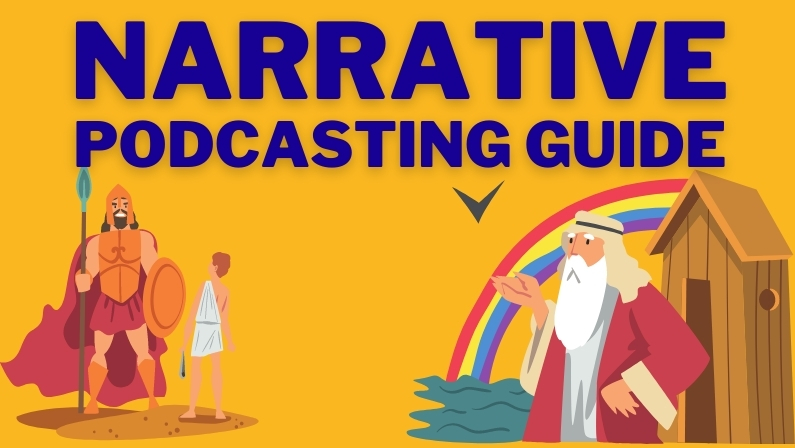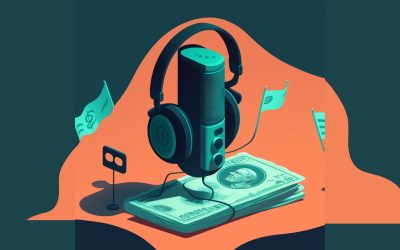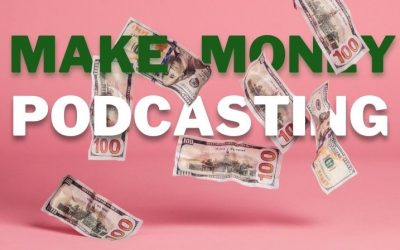Narrative podcasting is the best solution to achieve the storytelling formula on a podcast. Whether the story is Fictional or Non-fiction, narrative podcasting is the way to go.
Typically, whenever we hear an interesting story in a podcast or an audiobook, we forget ourselves into it, waiting for the next thing to happen, asking ourselves all sorts of questions, and with each scene, the stakes rise and the excitement is to the roof, feeling all sorts of emotions. At this point, it is almost impossible to stop without knowing the end and satisfy our curiosity.
This article is here to break down each step of the way, leaving you well aware of each aspect of storytelling in podcasting. Use it as a guideline to create your own Narrative Podcast.
Advantages of a Narrative Style Podcast

- It sustains the attention of your listeners: This is the ultimate outcome every content creator is dying to achieve, as it signals to social media algorithms that your content is worthy and it needs to be shown to wider audiences.
- Narrative podcast captivates your audience: Unlike the back-and-forth trade questions and answers between the interviewer and the guests that create sameness and results in the audience’s boringness, narrative podcasting totally immerses the focus of the listener on the story and narrator making it hard to check out.
- Foster honest emotions: Narrative podcasting has the effect of stirring up an intense emotional reaction in the listener. This benefit cannot be replicated in other forms of podcasting.
- Recreation of the events: A narrative podcast lends the perspective of the guest to the audience. The listener empathically re-lives the experience of the storyteller.
- No prejudice: As the podcast is an audio only medium, there’s no prejudice made based on the way the characters look and you’re incentivised to create the characters in your heads as you want to see them.
- Audio is one of the most visual mediums: Even though you don’t see anything, but the scenes that you create in your mind when you hear a story can last forever.
- Honesty: Audio also can be the most honest medium to communicate,
Setbacks of audio storytelling:
Audio also has some setbacks, For that, you need to use what audio is mostly good at and avoid situations where audio can’t pass the message across easily:
- Scall: you can’t explain the size of something just in words, it needs to have visuals that show the scall.
Solution: Always try to go for something audio is better at, for example: if the message you are trying to get across is how big and beautiful the landscape is, try and find some tourists admiring the view and explain it to you.
- Wrong Interpretation: when it comes to audio, the message may be interpreted wrongly
Solution: you need to make sure you have someone out of the process who can evaluate if the message you are aiming for if it’s interpreted correctly or not.
Creative Process of a Narrative Podcast
Here we’ll be discussing the process, structures, and format of a narrative podcast.
Narrative Podcasting takes on a less conventional approach to a show compared to regular interviews. You have the creative freedom to do a lot of interesting things with your show and explore different ways of narration.
The important thing is to have a clear goal in mind. The moment you have a vivid picture of the result, you can manipulate your recorded interview session to achieve the desired narrative podcast everyone is dying to listen to.
Preparatory Stage:

Before embarking on your dream narrative podcast, it is essential that you have set everything up for success. first of all:
- Get a reliable recording gear ready: No matter how confident you are in your post-production skills, nothing can fix a poor recording. Hence, get quality podcast recording gear to ensure that your sound comes out crisp and clean. If you are not sure about what you need, look at our prior article that recommends the best recording equipment for your podcast here.
- Research: Do proper research on your subject starting online by looking up everything you can find, then find people that can ultimately have a word to say in this story, search specifically for prior interviews or articles or comments and follow where the story takes you. if you think that the information you found online aren’t enough and you need to pre-interview potential guests before deciding who’s suitable for the show, Lookup our article on pre-interview questions.
- Have a roadmap: after harnessing as much information as you possibly can (online and preinterview) do an outline with your talking points and the areas you want to talk about to keep yourself focused and bring as many details that you judge important for the story.
- Compose a script: You’ll want to craft a podcast script to guarantee smooth delivery. As the conducting voice of the interview, it is essential that you sound sharp and decisive as you control the direction of the story.
Production:

Booking the voices:
Booking the right person can be tricky and can take a long time, you’re heading to search for someone who lived the story you’re trying to narrate, and has the ability to bring as many elements of it in a conversation.
this process can be divided into two parts:
Booking a specific individual:
One person who has the story: most of the time you know exactly who’s the person you want to talk to, they can be famous for that specific story, or they have inside information about the event or witnessed when the story happened.
Sometimes it can be as easy as a google search and a call to book that person, but most of the time it is difficult and tricky to get a hold of someone like that, so here are some lessons you need to have before you pursue this route:
- You need to get creative: a deep search in all the places of the internet about any way you might contact this person: this goes from social media to agents, to friends….. and the list goes on.
- Be a regular human: Once you find a way to contact them, through an email or a text or a message, be a regular human by using a language that both you and the person you’re connecting with can easily understand, be genuine and most importantly be polite.
- Consistency: Try every available way to make it happen, it might not be easy but you have to put the reps, and eventually you’ll get a response.
- Strick while the iron is hot: Once you get your chance, make sure you’re ready to use the opportunity as it shows up, it might not take long before it’s gone and you will never see it again.
Booking a category:
One person from a category out of many people you know can talk about the specific topic you want to tell a story about.
So you need to find this knowledgeable person who is a good talker (good storyteller):
First of all: you do a search on the internet of those people that already talk about the subject, also try to find other articles or interviews on the same subject and make a list of the people you want to reach out to.
Pre-interview people: Once you have the list, go for a pre-interview chat with each one of them, and look for someone that you vibe with and that has a lot of things to say about the event, look for a clue on when they start narrating or telling you about how it happened and the details.
Pick and choose: One or two from the candidates are going to be the top choice for your story, so make a formal interview with them and prepare yourself to get everything out of your interviewee, it’s your job to get the story out of them don’t expect them to give you everything you need.
Interviewing your guests:
Find your style: Start by finding what works for you (your style) and the types of questions you want to ask on your show, consistency is key when it comes to interviews, you need to have a format that feels genuine to your audience and represents who you are.
Personalize: After that you need to personalize it and come up with specific questions for each guest depending on the recent events or questions you know they might have an interesting view or a different opinion than what’s common out there.
Know your end point: Give your audience a sense of direction by pre-determining the topic and the different directions you’re taking the interview at the beginning of every episode, this will ensure you go deep rather than staying superficial and garnishing as much valuable information from your guest.
Stay on topic: Avoid getting too excited and branching off-topic. in case this happens, you are the one in control of the interview and you should use your power to put it back on track by calling it to their attention.
Keep an open mind: Sticking to your outline is okay, but when it comes to narrative podcasting It doesn’t hurt to allow your guest to go a little off-topic. They might end up revealing juicy content or a story within the narrative you didn’t know existed. after all, unnecessary details can always be cut out at the production stage.
Check out our prior article on interviewing a guest to develop a good sense for conducting amazing interviews.
Post Production

This is the most crucial part of a narrative podcast. Here is where your production skills roll into action. All your ingenious ideas are implemented at this stage of the process.
The question is: How do you create narratives from an interview without disturbing the rhythm of the show?
It might seem impossible but thanks to audio editing software like GarageBand or Audacity the possibilities are limitless.
Identify the golden nuggets: Before starting to work on the editing software, give a good listen to the entire recording to make sure you have a broad idea of what you got.
Then lay it down in the form of a transcript or just sticky notes with parts from the interview. Identify certain areas in the podcast like:
- Problems: areas like loopholes in the structure of a story due to gaps in the guest’s narrative.
- Excess information: irrelevant information to the topic that might bore your listeners.
- Notable quotes: Profound statements made by your guest during the show that might be relatable or of high value to your audience.
Timestamp these regions and tag them appropriately. This creates a good map for your task and helps you proceed in good order.
It’s time to start playing with the editing software
- Cut the fluff: Trim all the fluff from the recording, and keep the parts with the most action and emotion.
- Strategic pauses: Make strategic pauses at certain points of the guest’s story.
- Narration: Narrate what’s left and link through the events to make a complete story.
- Music and sound effects: Find music and sound effects that add color to your narration and speaks to the listener’s emotions.
This process will creatively refine the recording in a way that embodies all the vital parts of the story and offers a better context of the topic. Put it all together and you’ve got a masterpiece!
Pro Tips:
The power of shutting up:
The impulse of the human when doing any type of conversation is to fill the silence, but filling the silence is a form of inauthenticity because generally we’re filling the silence with small talk but sitting there and shutting up while letting the other express themselves is a brave act.
Finding What is of interest to others:
“We want to make people care about something that they don’t care about, but we think they should because we’re interested in it” and the trick is to find out what made you interested in the subject in the first place.






0 Comments